AUDI A4 AVANT 2008 Owners Manual
Manufacturer: AUDI, Model Year: 2008, Model line: A4 AVANT, Model: AUDI A4 AVANT 2008Pages: 368, PDF Size: 46.19 MB
Page 221 of 368
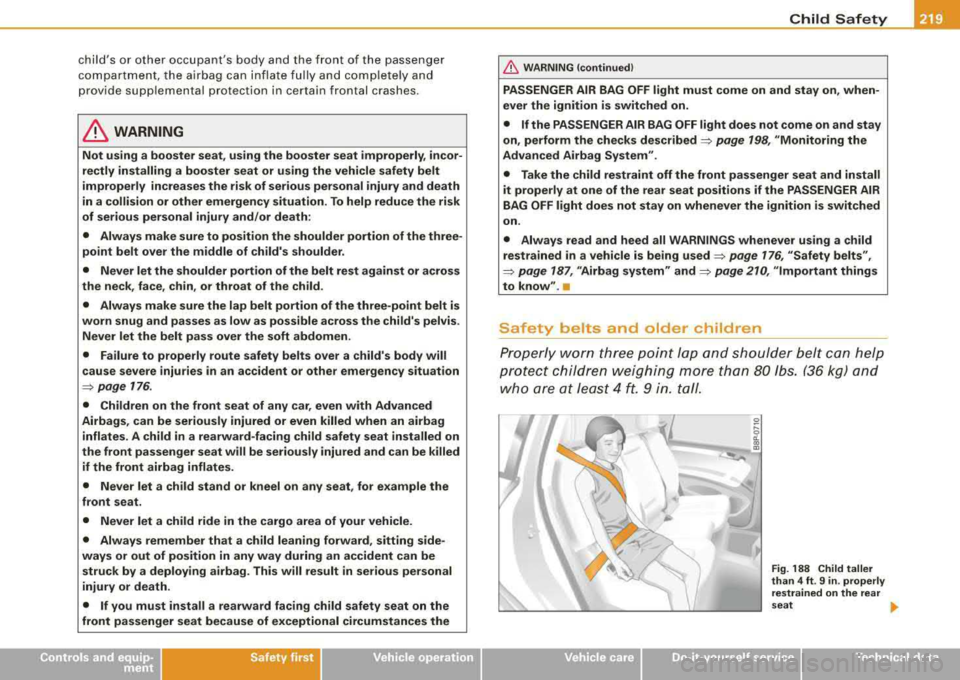
child's or other occupant's body and the front of the passeng er
c o m pa rtm ent, th e a ir ba g ca n i nfl ate fully and completely and
p rov ide supp lem ental p rotection in cert ain fr ontal crash es.
& WARNING
Not using a booster seat, using the booster seat improperly, incor
rectly installing a booster seat or using the vehicle safety belt
improperly increases the risk of serious personal injury and death
in a collision or other emergency situation. To help reduce the risk
of serious personal injury and /or death :
• Always make sure to position the shoulder portion of the three
point belt over the middle of child's shoulder .
• Never let the shoulder portion of the belt rest against or across
the neck , face , chin , or throat of the child .
• Always make sure the lap belt portion of the three -point belt is
worn snug and passes as low as possible across the child's pelvis .
Never let the belt pass over the soft abdomen.
• Failure to properly route safety belts over a child's body will
cause severe injuries in an accident or other emergency situation
=> page 176 .
• Children on the front seat of any car, even with Advanced
Airbags, can be seriously injured or even killed when an airbag
inflates . A child in a rearward-facing child safety seat installed on
the front passenger seat will be seriously injured and can be killed
if the front airbag inflates.
• Never let a child stand o r kneel on any seat , for example the
front seat .
• Never let a child ride in the cargo area of your vehicle.
• Always remember that a child leaning forward , sitting side
ways or out of position in any way during an accident can be
struck by a deploy ing a irbag. This will result in serious personal
injury or death .
• If you must install a rearward facing child safety seat on the
front passenger seat because of exceptional circumstances the
Safety
first
Child Safety
& WARNING (continued )
PASSENGER AIR BAG OFF light must come on and stay on , when
ever the ignition is switched on.
• If the PASSENGER AIR BAG OFF light does not come on and stay
on , perform the checks
described => page 198, "Monitoring the
Advanced Airbag System" .
• Take the child restraint off the front passenger seat and install
it properly at one of the rear seat positions if the PASSENGER AIR
BAG OF F light does not stay on whenever the ignition is switched
on .
• Always read and heed all WARNINGS whenever using a child
restrained in a vehicle is being
used => page 176 , "Safety belts" ,
=> page 187, "Airbag system" and => page 210 , "Important thing s
to know ".•
Safety belts and older children
Prop erl y worn t hree point la p and sho ulder belt can h elp
p ro te ct childre n weighing more th an 8 0 lbs . (36 kg) and
w ho a re at lea st 4 ft. 9 in. tall .
~ .... 0 cL (X) a,
Fig . 18 8 Child taller
than 4 ft . 9 in . properly
restrained on the rear
s eat
.,_
•
irechnical data
Page 222 of 368
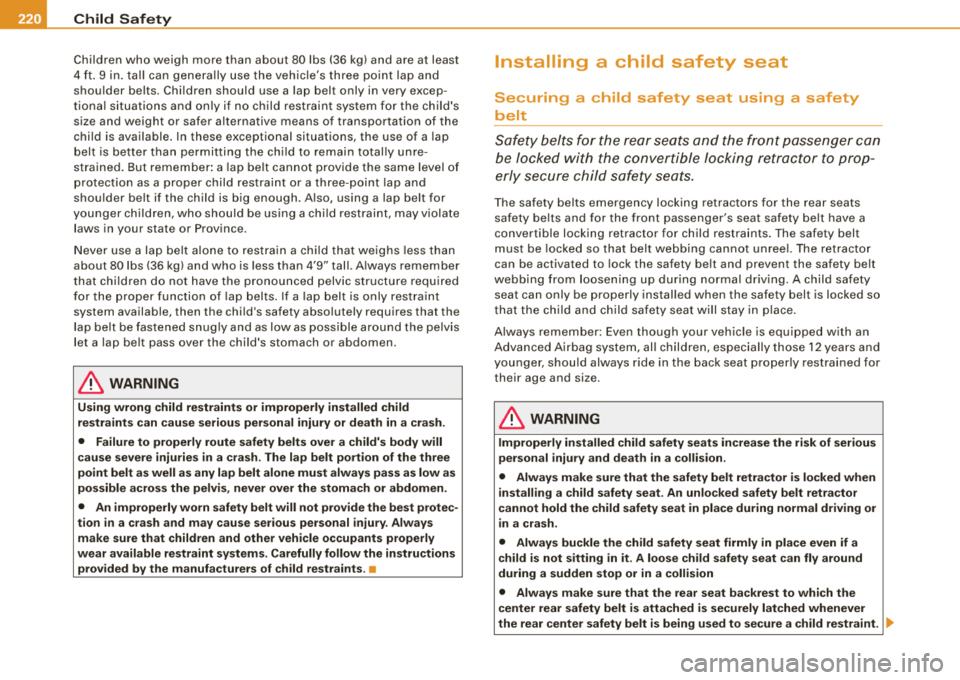
__ ....,;;C;..;.h.;.; i.;.;ld ;;,;,__; S;;;.; a;;;;. f;;..; e;;;.; t~ y""------------------------------------------------
Children who weigh more than about 80 lbs (36 kg) and are at least
4 ft . 9 in. tal l can genera lly use the veh ic le's three po int lap a nd
shou lder belts . Chi ldren should use a lap belt only in very excep
tiona l situations and on ly if no child restraint system for the child's
size and weight or safer a lternative means of transportation of the
child is available. In these exceptiona l situations, the use of a lap
belt is better t han permitting t he ch ild to re main total ly unre
strained. But remember : a lap be lt cannot provide the same level of
protection as a proper c hild restraint or a t hree -poi nt lap and
shou lder be lt if the child is big enough . A lso, using a lap belt for
younger chi ldre n, who s hould be us ing a chi ld restrai nt, may v iola te
l aws in your state or Province .
N ever use a lap belt alone to rest ra in a chi ld that we ig hs less than
about 80 lbs (36 kg) and w ho is less t han 4'9" ta ll. A lways remember
t hat chi ld ren do not have the pronounced pelv ic structure requ ired
f or t he proper function o f lap belts . If a lap belt is o nly restra int
system available, then the chi ld's safety absolutely requires that the
l ap be lt be fastened snug ly and as low as possible around t he pelv is
l et a lap belt pass over the chi ld's stomach or abdomen .
& WARNING
Using wrong child restraints or improperly installed child
restraints can cau se seriou s personal injury or death in a crash.
• Failure to properly route safety belt s over a child's body will
cau se severe injurie s in a crash . The lap belt portion of the three
point belt a s well as any lap belt alone must always pass as low as
po ssible acros s the pelvis, never over the stomach or abdomen.
• An improperly worn safety belt will not provide the best protec
tion in a crash and may cause serious personal injury . Al ways
make sure that children and other vehicle occupants properly
wear available restraint sy stem s. Carefully follow the in struction s
prov ided by the manufacturers of child restraints .
•
Installing a child safety seat
Securing a child safety seat using a safety
belt
S afe ty belts for the rea r seats and the fr ont pa ssenger can
be locke d with the c onvertible locking retract or to prop
erly secure child safety seats.
T he safe ty belts emergency locking re tracto rs fo r the rea r sea ts
sa fety be lts a nd for t he front passenger's seat safety belt have a
conve rtible lock ing ret ractor for child rest ra ints . The safety belt
must be loc ked so t hat belt webbing ca nnot unree l. The retractor
can be activated to lock the safety be lt and prevent the safety be lt
webbi ng from l oosen ing up dur ing normal dr ivi ng. A c hild sa fe ty
seat can only be properly instal led when the safety belt is locked so
t hat t he ch ild and c hild safety seat will s tay in place .
A lways remember: Even though your vehicle is equipped with an
Advanced Ai rbag sys tem, al l c h ild ren, especially those 12 years and
younger, should always r ide in the back seat proper ly restra ined for
their age and size.
& WARNING
Improperly installed child safety seats increase the risk of serious
per sonal injury and death in a collision .
• Always make sure that the safety belt retractor is locked when
installing a child safety seat. An unlo cked safety belt retra ctor
cannot hold the child safety seat in pla ce during normal driving or
in a crash.
• Alway s buckle the child safety seat firmly
in place even if a
c hild is not sitting in it. A loose child safety seat can fly around
during a sudden stop or in a collision
• Alway s make sure that the rear seat backre st to which the
center rear safety belt is attached is securely latched whenever
the rear center safety belt is being u sed to se cure a child re straint.
_,.
Page 223 of 368
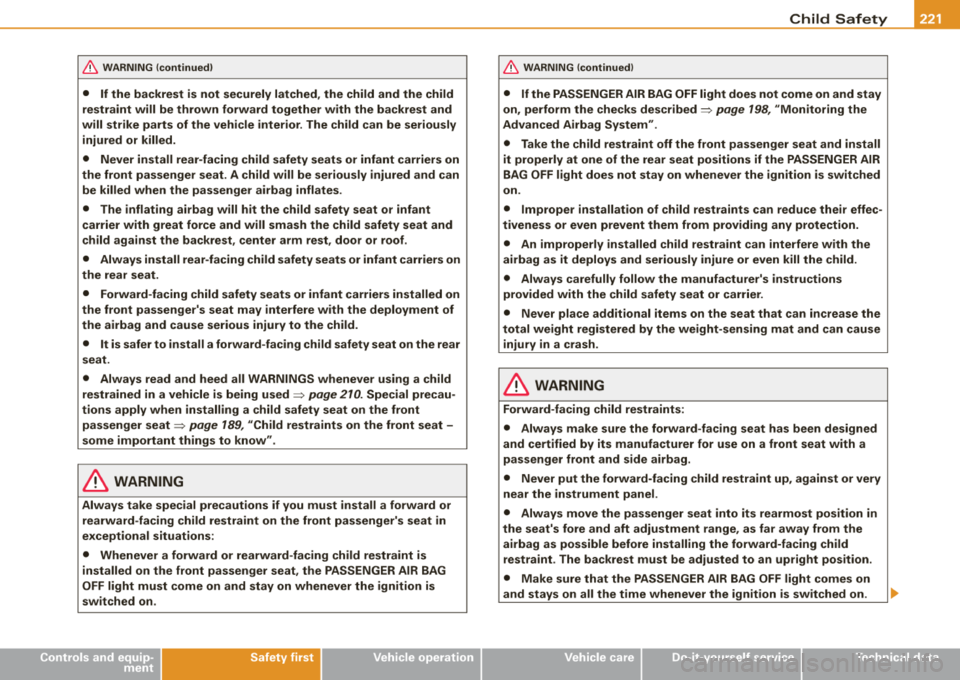
& WARNING (continued)
• If the backrest is not securely latched, the child and the child
restraint will be thrown forward together with the backrest and
will strike parts of the vehicle interior . The child can be seriously
injured or killed.
• Never install rear-facing child safety seats or infant carriers on
the front passenger seat. A child will be seriously injured and can be killed when the passenger airbag inflates .
• The inflating airbag will hit the child safety seat or infant
carrier with great force and will smash the child safety seat and
child against the backrest, center arm rest, door or roof.
• Always install rear-facing child safety seats or infant carriers on
the rear seat.
• Forward-facing child safety seats or infant carriers installed on
the front passenger's seat may interfere with the deployment of
the airbag and cause serious injury to the child.
• It is safer to install a forward-facing child safety seat on the rear
seat.
• Always read and heed all WARNINGS whenever using a child
restrained in a vehicle is being used
=> page 210. Special precau
tions apply when installing a child safety seat on the front
passenger
seat => page 189, "Child restraints on the front seat -
some important things to know".
& WARNING
Always take special precautions if you must install a forward or
rearward -facing child restraint on the front passenger's seat in
exceptional situations :
• Whenever a forward or rearward-facing child restraint is
installed on the front passenger seat, the PASSENGER AIR BAG
OFF light must come on and stay on whenever the ignition is
switched on.
Controls and equip ment Safety first
Vehicle operation
Child Safety
& WARNING (continued)
• If the PASSENGER AIR BAG OFF light does not come on and stay
on, perform the checks described
=> page 198, "Monitoring the
Advanced Airbag System" .
• Take the child restraint off the front passenger seat and install
it properly at one of the rear seat positions if the PASSENGER AIR
BAG OFF light does not stay on whenever the ignition is switched
on .
• Improper installation of child restraints can reduce their effec
tiveness or even prevent them from providing any protection.
• An improperly installed child restraint can interfere with the
airbag as it deploys and seriously injure or even kill the child.
• Always carefully follow the manufacturer's instructions
provided with the child safety seat or carrier.
• Never place additional items on the seat that can increase the
total weight registered by the weight -sensing mat and can cause
injury in a crash.
& WARNING
Forward-facing child restraints:
• Always make sure the forward-facing seat has been designed
and certified by its manufacturer for use on a front seat with a
passenger front and side airbag.
• Never put the forward-facing child restraint up, against or very
near the instrument panel .
• Always move the passenger seat into its rearmost position in
the seat's fore and aft adjustment range, as far away from the airbag as possible before installing the forward-facing child
restraint. The backrest must be adjusted to an upright position.
• Make sure that the PASSENGER AIR BAG OFF light comes on
and stays on all the time whenever the ignition is switched on. ...
Vehicle care Do-it-yourself service Technical data
Page 224 of 368
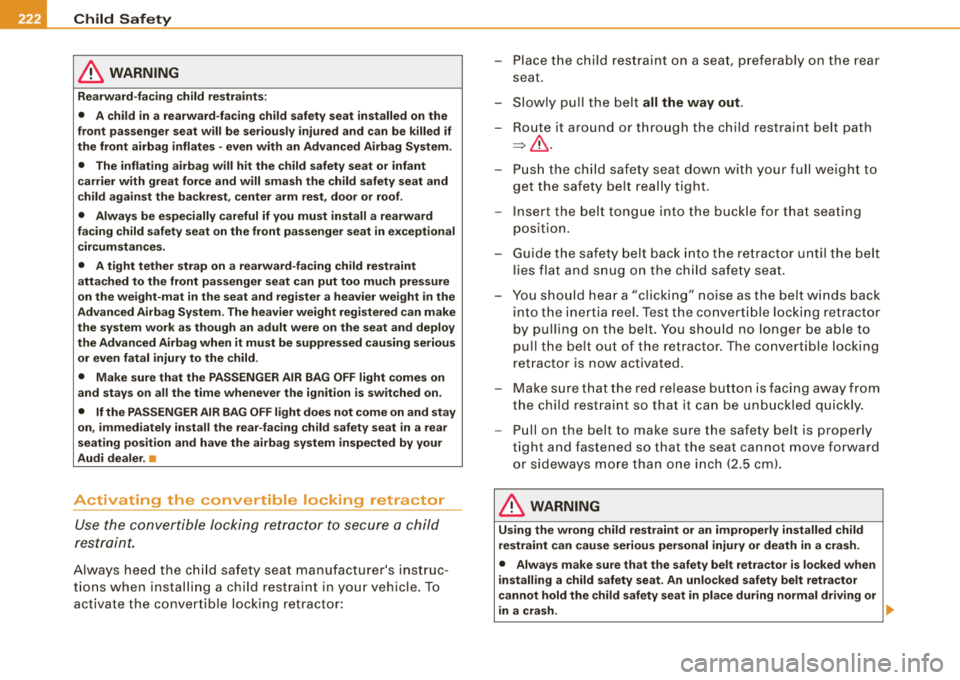
llfflJ_....:::C:.:.h :.:.i::.::
ld :...:: S::.::a :.:f .:::e ::.::t .!..y ____________________________________________ _
& WARNING
Rearward-facing child restraints:
• A child in a rearward-facing child safety seat installed on the
front passenger seat will be seriously injured and can be killed if
the front airbag inflates -even with an Advanced Airbag System.
• The inflating airbag will hit the child safety seat or infant
carrier with great force and will smash the child safety seat and
child against the backrest, center arm rest, door or roof.
• Always be especially careful if you must install a rearward
facing child safety seat on the front passenger seat in exceptional
circumstances.
• A tight tether strap on a rearward-facing child restraint
attached to the front passenger seat can put too much pressure
on the weight-mat in the seat and register a heavier weight in the
Advanced Airbag System. The heavier weight registered can make
the system work as though an adult were on the seat and deploy
the Advanced Airbag when it must be suppressed causing serious or even fatal injury to the child.
• Make sure that the PASSENGER AIR BAG OFF light comes on
and stays on all the time whenever the ignition is switched on.
• If the PASSENGER AIR BAG OFF light does not come on and stay
on, immediately install the rear-facing child safety seat in a rear
seating position and have the airbag system inspected by your
Audi dealer. •
Activating the convertible locking retractor
Use the convertible locking retractor to secure a child
restraint.
Always heed the child safety seat manufacturer's instruc
tions when installing a child restraint in your vehicle. To
activate the convertible locking retractor:
-Place the child restraint on a seat, preferably on the rear
seat.
-Slowly pull the belt all the way out.
-Route it around or through the child restraint belt path
=>& .
-Push the child safety seat down with your full weight to
get the safety belt really tight.
-Insert the belt tongue into the buckle for that seating
position.
-Guide the safety belt back into the retractor until the belt
lies flat and snug on the child safety seat.
-You should hear a "clicking" noise as the belt winds back
into the inertia reel. Test the convertible locking retractor
by pulling on the belt. You should no longer be able to
pull the belt out of the retractor. The convertible locking
retractor is now activated.
-Make sure that the red release button is facing away from
the child restraint so that it can be unbuckled quickly.
-Pull on the belt to make sure the safety belt is properly
tight and fastened so that the seat cannot move forward
or sideways more than one inch (2.5 cm).
& WARNING
Using the wrong child restraint or an improperly installed child
restraint can cause serious personal injury or death in a crash.
• Always make sure that the safety belt retractor is locked when
installing a child safety seat. An unlocked safety belt retractor
cannot hold the child safety seat in place during normal driving or
in a crash.
~
Page 225 of 368
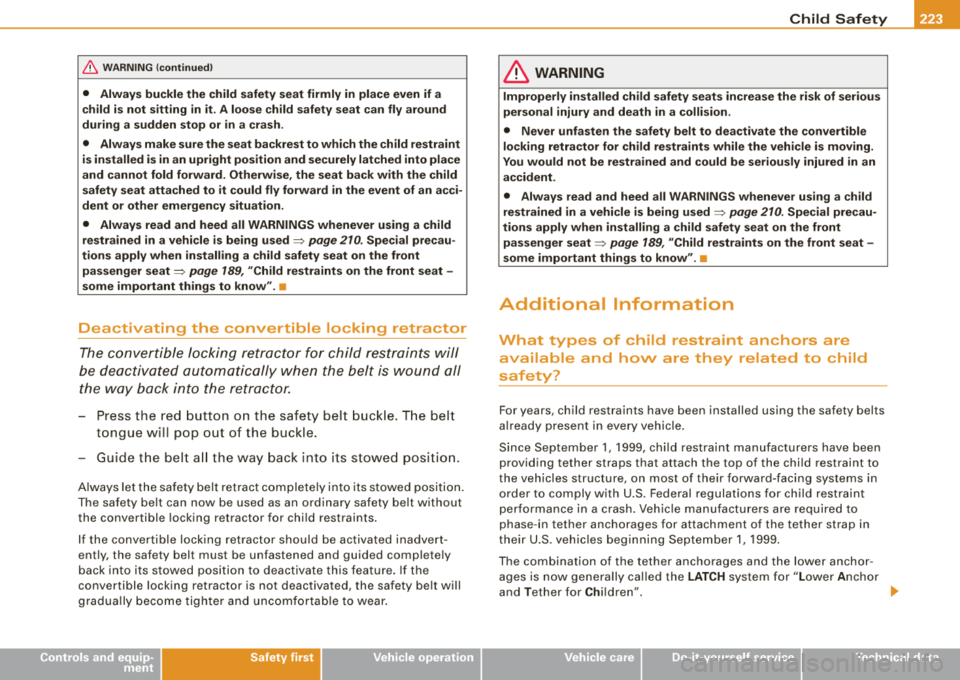
____________________________________________ C_ h_ i_ ld _ S_a_ f_e _t .:..Y _ .... 911
& WARNING (continued)
• Always buckle the child safety seat firmly in place even if a
child is not sitting in it. A loose child safety seat can fly around
during a sudden stop or in a crash.
• Always make sure the seat backrest to which the child restraint
is installed is in an upright position and securely latched into place
and cannot fold forward. Otherwise, the seat back with the child
safety seat attached to it could fly forward in the event of an acci
dent or other emergency situation.
• Always read and heed all WARNINGS whenever using a child
restrained in a vehicle is being used
=> page 210. Special precau
tions apply when installing a child safety seat on the front
passenger
seat=> page 189, "Child restraints on the front seat -
some important things to know" .•
Deactivating the convertible locking retractor
The convertible locking retractor for child restraints will
be deactivated automatically when the belt is wound all
the way back into the retractor.
- Press the red button on the safety belt buckle. The belt
tongue will pop out of the buckle.
- Guide the belt all the way back into its stowed position.
Always let the safety belt retract completely into its stowed position.
The safety belt can now be used as an ordinary safety belt without
the convertible locking retractor for child restraints.
If the convertible locking retractor should be activated inadvert
ently, the safety belt must be unfastened and guided completely
back into its stowed position to deactivate this feature. If the
convertible locking retractor is not deactivated, the safety belt will
gradually become tighter and uncomfortable to wear.
Controls and equip ment Safety first Vehicle operation
LJ}. WARNING
Improperly installed
child safety seats increase the risk of serious
personal injury and death in a collision.
• Never unfasten the safety belt to deactivate the convertible
locking retractor for child restraints while the vehicle is moving.
You would not be restrained and could be seriously injured in an
accident.
• Always read and heed all WARNINGS whenever using a child
restrained in a vehicle is being used
=> page 210. Special precau
tions apply when installing a child safety seat on the front
passenger
seat => page 189, "Child restraints on the front seat -
some important things to know" .•
Additional Information
What types of child restraint anchors are
available and hovv are they related to child
safety?
For years, child restraints have been installed using the safety belts
already present in every vehicle.
Since September 1, 1999, child restraint manufacturers have been
providing tether straps that attach the top of the child restraint to
the vehicles structure, on most of their forward-facing systems in order to comply with U.S. Federal regulations for child restraint
performance in a crash. Vehicle manufacturers are required to
phase -in tether anchorages for attachment of the tether strap in
their U.S. vehicles beginning September 1, 1999.
The combination of the tether anchorages and the lower anchor ages is now generally called the LATCH system for "Lower Anchor
and Tether for Children".
.,._
Vehicle care Do-it-yourself service Technical data
Page 226 of 368
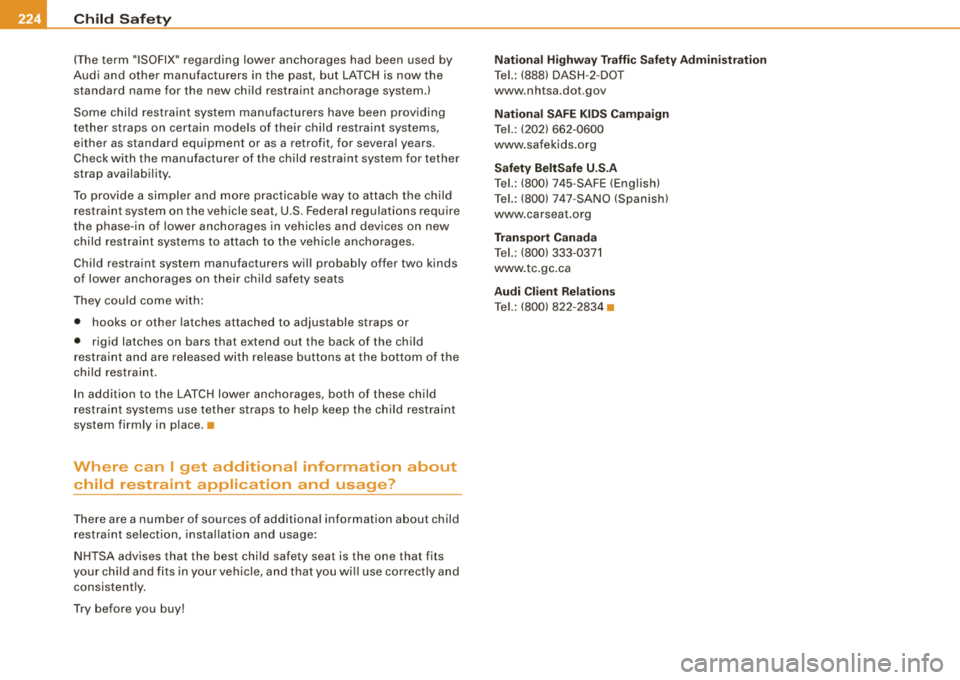
___ C_h_ i_ld _ S_ a_ f_ e_ t--= y'-------------------------------------------------
(The term " ISOFIX" regarding lower anchorages had been used by
Audi and other man ufacturers in the pas t, but LATC H is now the
standard name for the new child restraint anchorage system.)
Some chi ld restraint system manufacture rs have been providing
tet her straps on certain mode ls of their child restra int systems ,
either as standard equipment or as a retrofit, for several years .
Chec k w ith the manu factu rer o f th e ch ild restra int syste m for tether
strap avai labili ty .
T o provide a simpler and more practicab le way to attach the child
restraint system on the vehicle seat, U .S . Federal regulations require
t he phase -in of lowe r ancho rages in vehicles and devices on new
child restraint systems to attach to the veh icle anchorages.
Ch ild restraint system manufacturers will probably offer two k inds
o f lower a nchorages on their child safety seats
T hey cou ld come with :
• hooks or ot her latches attached to adjustable st raps or
• rigid latches on bars that extend out the back of the ch ild
r est raint and are re leased w ith release but tons a t the bottom of the
child restra int.
I n addition to the LA TCH lower anchorages, both of these child
r estra int syst ems use tether straps to help keep the c hild restraint
system firmly in p lace .
•
Where can I get additional information about
child restraint application and usage?
T here are a n umbe r of so urces of additional info rma tion abo ut child
r estra int selection, i nsta llat io n and usage :
NH TSA advises that the best chi ld safety seat is the one that fits
your c hild and f its in your ve hicle, a nd that y ou will u se c orrectly and
consistent ly.
T ry befo re you buy! National Highway Traffic Safety Administration
Tel. : (888) DAS H-2 -DOT
www.nhtsa .dot .gov
Nation al SAFE KIDS Camp aign
Tel.: (202) 662 -0600
www .sa fek ids.org
Safety BeltSafe U .S .A
T el.:
(800! 745 -SAFE (Eng lish)
Tel. : (800) 7 47-SANO (S pan is h )
www.carseat.org
Transport Canada
T el. : (800) 333 -037 1
www .tc.gc.ca
Audi Client Relations
Tel. : (80 0) 82 2-2834
•
Page 227 of 368
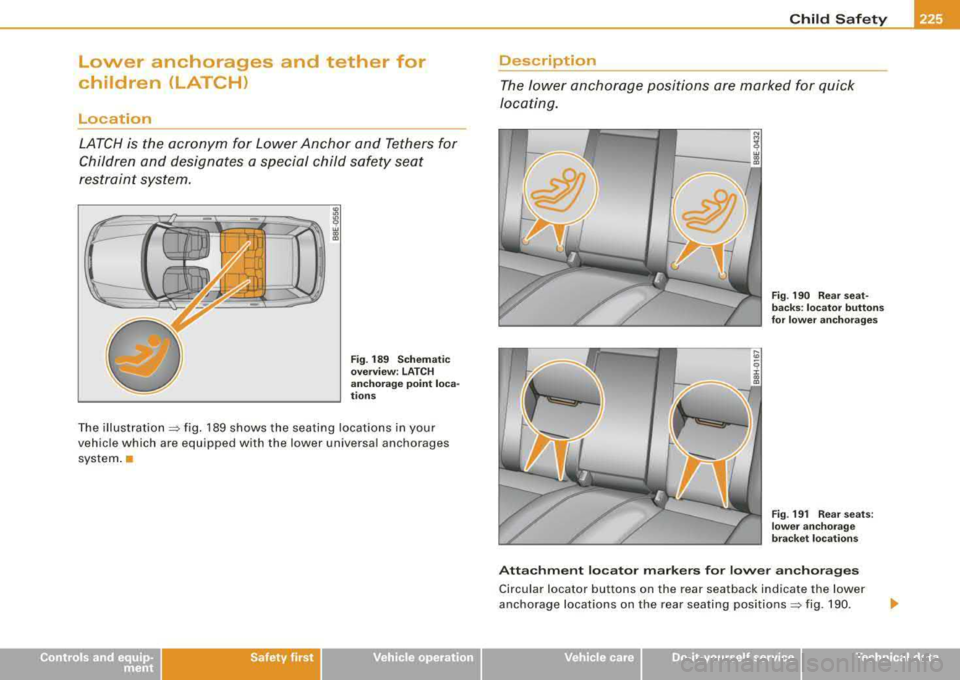
Lower anchorages and tether for
children (LATCH)
Location
LATCH is the acronym for Lower Anchor and Tethers for
Children and designates a special child safety seat
restraint system.
Fig . 189 Schematic
overview : LATCH
anchorage point loca
tions
The illustration ~ fig. 189 shows the seating locations in your
vehicle which are equipped with the lower universal anchorages
system .•
Safety first
Child Safety
Description
The lower anchorage positions are marked for quick
locating.
ij
w r-----:ll
Fig . 190 Rear seat
backs: locator buttons
for lower anchorages
Fig . 191 Rear seats:
lower anchorage
bracket locations
Attachment locator markers for lower anchorages
Circular locator buttons on the rear seatback indicate the lower
anchorage locations on the rear seating
positions~ fig. 190.
Technical data
Page 228 of 368
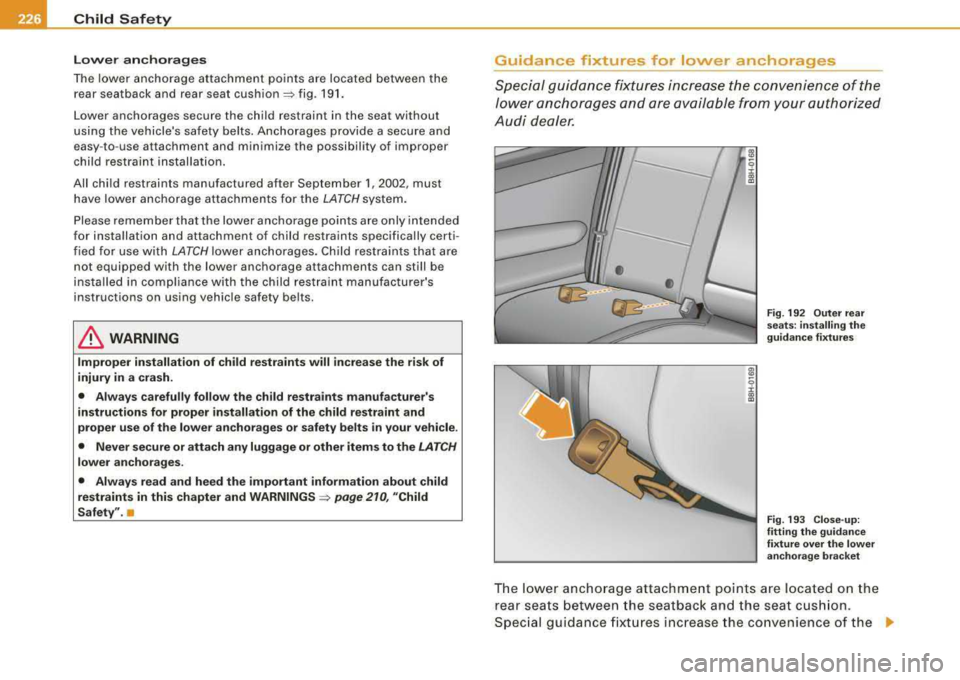
___ C_h_ i_ld _ S_ a_ f_ e_ t--= y'-------------------------------------------------
L o w er an chorag es
The lower anchorage attachment points are located between the
rear seatback and rear seat
cushion=> fig. 191.
Lower anchorages secure the child restraint in the seat without
using the vehicle's sa fety be lts. Anchorages provide a secure and
easy -to -use attachment and minimize the possibility of improper
child restraint instal lation .
All child restraints manufactured after September 1, 2002, must have lower anchorage a ttachments for the
LATCH system .
Please remember tha t the lower anchorage points are only intended
for insta llation and attachment of child restraints specifica lly certi
f ied for use with
LATCH lower anchorages. Ch ild restrain ts that are
not equipped with the lower anchorage attachments can still be
insta lled in comp liance with the child res traint manufactu rer's
instructions on using vehicle safety be lts .
& WARNING
Improper installation of child restraints will increase the risk of
injury in a crash .
• Always carefully follow the child restra int s manufa cturer's
instructions for proper in sta llation of the child restraint and
proper use of the lower an chor ages or safety be lts in your vehicle .
• Never se cure or attach any luggage or other item s to the
LAT CH
lower an chorages .
• Alway s read and heed the important inform ati on about child
r e straints in this chapter and
WARNINGS => page 210, "Child
Safety ".•
Guidance fixtures for lower anchorages
Spe cial guidance fi xtur es i ncre ase t he c onvenien ce of the
lo wer anch ora ges and are avail able from your autho rized
Audi dealer.
Fig . 19 2 Out er r ea r
sea ts : in sta llin g the
guidanc e fixture s
F ig . 19 3 C lose- up:
fitting the guid an ce
fixtur e over the lo wer
a n chor age bra cket
The lo wer ancho rage attachme nt points are located on the
rear seats between the seatbac k and the seat cus hion.
S pec ial guidance fixt ur es increase the convenience of the
.,_
Page 229 of 368
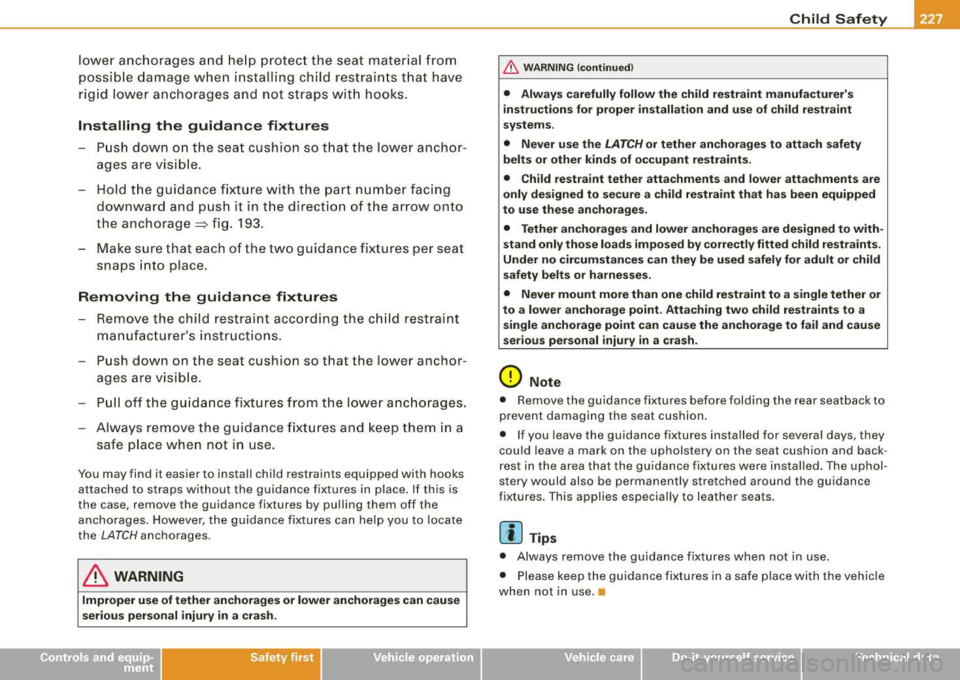
Child Safety -
---------------''------'
lower anchorages and help protect the seat material from
possible damage when installing child restraints that have
rigid lower anchorages and not straps with hooks.
Installing the guidance fixtures
- Push down on the seat cushion so that the lower anchor
ages are visible.
- Hold the guidance fixture with the part number facing downward and push it in the direction of the arrow onto
the
anchorage => fig. 193.
- Make sure that each of the two guidance fixtures per seat snaps into place.
Removing the guidance fixtures
- Remove the child restraint according the child restraint
manufacturer's instructions.
- Push down on the seat cushion so that the lower anchor
ages are visible.
- Pull off the guidance fixtures from the lower anchorages.
- Always remove the guidance fixtures and keep them in a
safe place when not in use.
You may find it easier to install child restraints equipped with hooks
attached to straps without the guidance fixtures in place. If this is
the case, remove the guidance fixtures by pulling them off the
anchorages. However, the guidance fixtures can help you to locate
the
LATCH anchorages.
& WARNING
Improper use of tether anchorages or lower anchorages can cause
serious personal injury in a crash.
Controls and equip ment Safety first Vehicle operation
& WARNING
(continued)
• Always carefully follow the child restraint manufacturer's
instructions for proper installation and use of child restraint
systems.
• Never use the
LATCH or tether anchorages to attach safety
belts or other kinds of occupant restraints.
• Child restraint tether attachments and lower attachments are
only designed to secure a child restraint that has been equipped
to use these anchorages.
• Tether anchorages and lower anchorages are designed to with
stand only those loads imposed by correctly fitted child restraints.
Under no circumstances can they be used safely for adult or child
safety belts or harnesses.
• Never mount more than one child restraint to a single tether or
to a lower anchorage point. Attaching two child restraints to a
single anchorage point can cause the anchorage to fail and cause
serious personal injury in a crash.
0 Note
• Remove the guidance fix tures before folding the rear seatback to
prevent damaging the seat cushion.
• If you leave the guidance fixtures ins talled for several days , they
could leave a mark on the upholstery on the seat cushion and back
rest in the area that the guidance fixtures were ins talled. The uphol
stery would also be permanently stretched around the guidance
fixtures. This applies especially to leather seats .
[ i] Tips
• Always remove the guidance fixtures when not in use.
• Please keep the guidance fixtures in a safe place with the vehicle
when not in use .•
Vehicle care Do-it-yourself service Technical data
Page 230 of 368
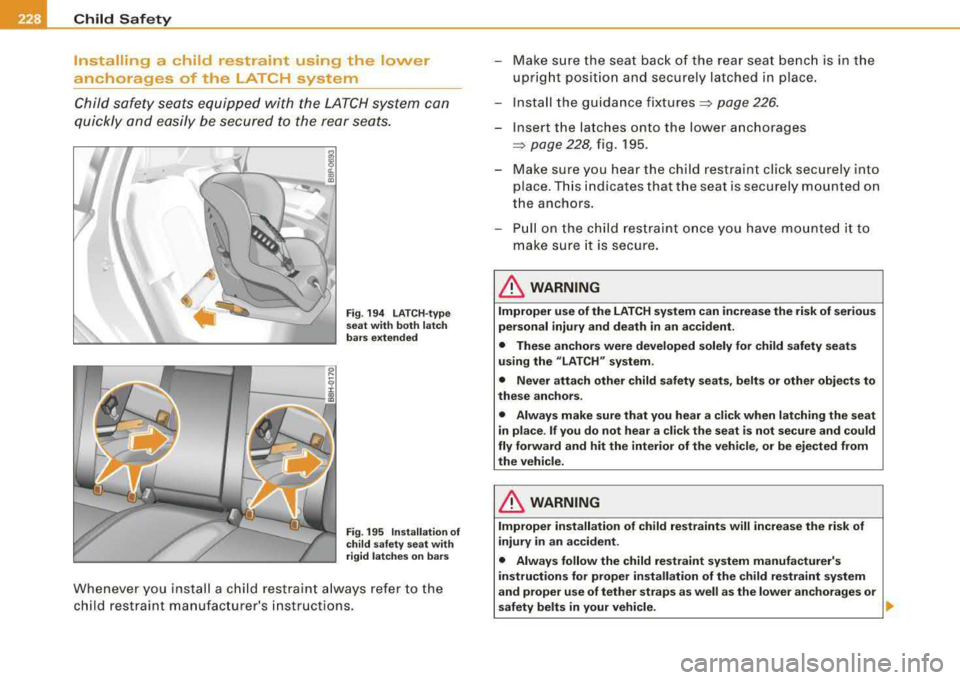
___ C_h_ i_ld _ S_ a_ f_ e_ t--= y'-------------------------------------------------
Installing a child restraint using the lower
anchorages of the LATCH system
Child safety seats equipped with the LATCH system can
quickly and easily be secured to the rear seats.
Fig . 194 LATCH-type
seat with both latch
bars extended
Fig . 195 Installation of
child safety seat with
rigid latches on bars
Whenever you install a child restra int always refer to the
child restra int manufacturer's instructions.
-Make sure the seat back of the rear seat bench is in the
upright position and securely latched in place.
- Insta ll the guidance
fixtures ~ page 226.
- Insert the latche s onto the lower anchorages
=> page 228, fig. 195.
- Make sure you hear the child restraint click securely into
place. This indicates that the seat is securely mounted on
the anchors.
-Pull on the child restraint once you have mounted it to
make sure it is secure.
& WARNING
Improper use of the LATCH system can increase the risk of serious
personal injury and death in an accident.
• These anchors were developed solely for child safety seats
using the
" LATCH" system .
• Never attach other child safety seats, belts or other objects to
these anchors.
• Always make sure that you hear a click when latching the seat
in place. If you do not hear a click the seat is not secure and could
fly forward and hit the interior of the vehicle, or be ejected from
the vehicle.
& WARNING
Improper installation of child restraints will increase the risk of
injury in an accident.
• Always follow the child restraint system manufacturer's
instructions for proper installation of the child restraint system
and proper use of tether straps as well as the lower anchorages or
safety belts in your vehicle.
.,..